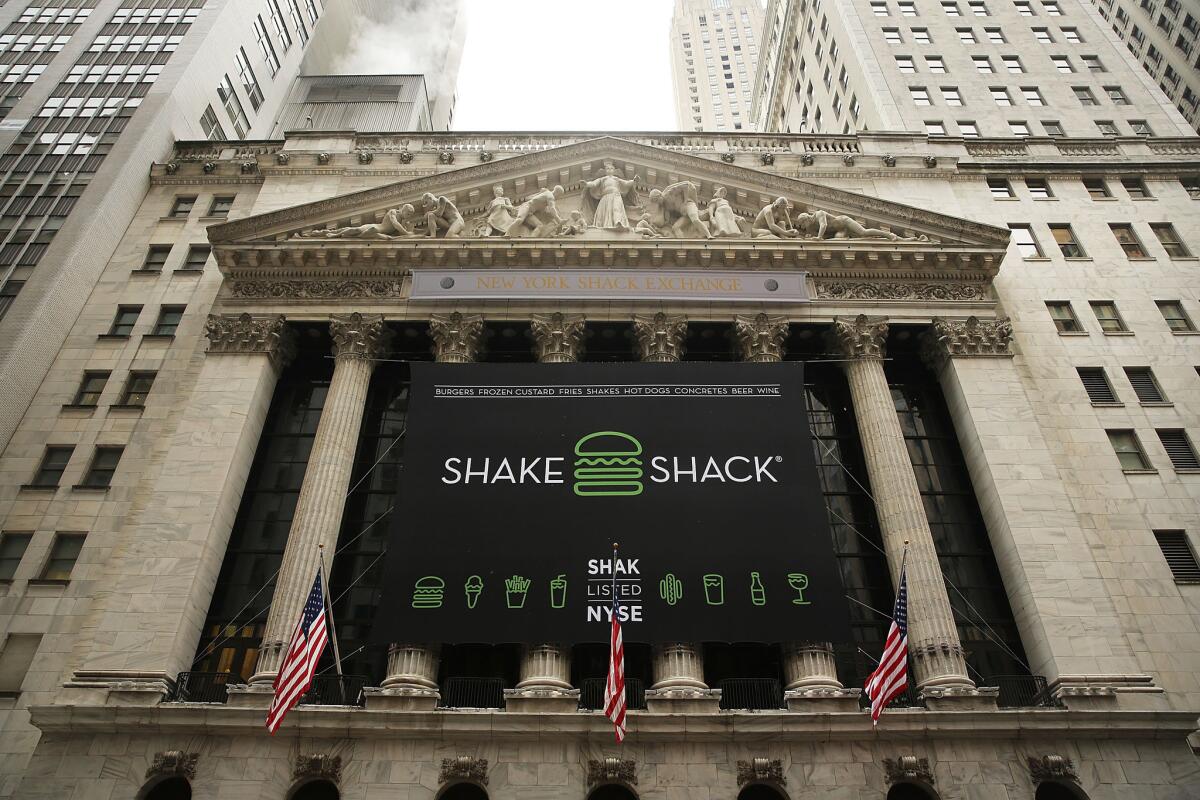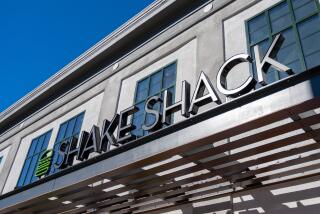Is Shake Shack the next Krispy Kreme?

- Share via
A stock market that has been gyrating insanely all month on its way to a 3% loss can be forgiven for seeking solace in a buzzy initial public offering. But that in itself doesn’t make Shake Shack, the star IPO of the moment, a good buy.
Shake Shack is a onetime Manhattan food truck that has grown into a multi-state, 63-store, high-end burger chain. Its IPO was priced to open Friday at $21 and closed at $45.90, for a one-day gain of more than 118%. Considering how much money an underpricing of that magnitude left on the table, one would think its lead underwriters, JPMorgan and Morgan Stanley, would be fired or at least investigated, but let it go.
The important question for investors is whether Shake Shack has the growth and profit potential that a market valuation of more than $1.6 billion indicates. The stock market record of the restaurant sector implies two possible outcomes.
One is the pattern shown thus far by Chipotle Mexican Grill, a fast-casual burrito chain that went public in 2006 at $42 with 500 stores, and closed Friday at $709.84 and 1,700 stores. Shake Shack investors hope that’s their new stock’s future. It’s right to observe that Shake Shack’s price per trailing 12-month sales is about four times as high as Chipotle’s was on IPO day.
But what if it ends up looking like Krispy Kreme or Crumbs Bake Shop?
The first, a big doughnut chain, went public in 2000 amid a Shake Shack-like frenzy. Then it got hit with an accounting investigation by the Securities and Exchange Commission. It’s had its frenzied ups and downs, soaring to more than $44 in 2003 after going public at about $8.25 (both prices split- and dividend-adjusted). On Friday Krispy closed at $19.47 -- a decent gain over 15 years if you got in at the beginning and held on, but not too mouth-watering considering the wild ride.
Crumbs went public in 2011 amid the gourmet-cupcake frenzy, when those hand-sized calorie bombs looked like the global future of dessert. It went public at $13.10, and last year it went bankrupt. So much for its expectations of “bringing back the neighborhood bakery,” as a co-founder mapped out its ambitions.
It’s hard to know just now which direction Shake Shack is headed. It’s not quite a national chain (its closest location to Los Angeles is a restaurant on the Las Vegas Strip), and its goal is to expand from 63 stores to 450 over a period of years. That implies that its ambitions can be kept in check.
What it does have, however, is hype by the plateful. That’s a particular danger for a restaurant chain centered in New York, where Wall Street analyst types can be overly swayed by local trendiness. Shake Shack’s core menu is burgers, fries and shakes, none of which is an especially innovative product. The chain claims to work from only the best ingredients, but who doesn’t?
Investors shouldn’t be swayed by the uplifting story of Shake Shack’s origins as a New York food truck. It’s been part of the empire of restaurateur Danny Meyer, whose Union Square Hospitality Group is known for comforting, high-quality themed New York restaurants.
But you’re not buying shares in USHG; you’re buying Shake Shack. Whether the chain has legs is uncertain. A core meals of cheeseburger with fries and a shake clocks in at about 1,600 calories, which is getting pretty close to a full caloric dose for a normal adult. There’s nothing wrong with that as an occasional meal out, but it may limit the repeat-customer market to 25- to 30-year-olds looking to step up in gourmet-dom from Carl’s Jr.
Restaurants, as is well known, are very tough businesses, and running them under Wall Street’s glare isn’t the same as running them as a private partnership. It’s not especially comforting that Shake Shack’s explanation of what makes it “special” is written in corporatized New Age gibberish. The principles of business “championed by Danny Meyer,” according to its public prospectus, include recruiting and developing “a team with the innate ‘personality to please’ that cannot be taught. We look for people who are warm, friendly, motivated, caring, self-aware and intellectually curious team members.... Our team is trained to understand and practice the values of Enlightened Hospitality: caring for each other, caring for our guests, caring for our community, caring for our suppliers and caring for our investors.”
But what does that mean in profit and loss? If you have money to invest, it’s your call.
Keep up to date with the Economy Hub. Follow @hiltzikm on Twitter, see our Facebook page, or email mhiltzik@latimes.com.
More to Read
Inside the business of entertainment
The Wide Shot brings you news, analysis and insights on everything from streaming wars to production — and what it all means for the future.
You may occasionally receive promotional content from the Los Angeles Times.











